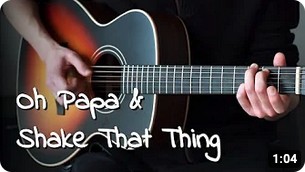Basic minor chords
Below are the most basic minor chords. Most of these chord shapes are open chord shapes, which means that not all strings are fretted. More advanced minor chord shapes that can be moved around the neck will be discussed later.
Minor chords have a sad and depressing sound. They are made up of three notes: the root note, the minor third (root note + 3 semitones) and the perfect fifth (root note + 7 semitones). Here is help on how to read chord diagrams.
D minor

‣ The low E and A strings are not part of the D minor chord shape, so make sure they are muted.
E minor

F minor




‣ F minor variation 1 is the simplest version of F minor. The low E and A strings are not part of this chord shape, so make sure they are muted. If you want a fuller sound, variation 2 or 3 is recommended. Variation 2 is a barre chord, while variation 3 is played with the thumb over the neck. I personally prefer variation 3 because my wrist hurts quickly when playing barre chords. I also discussed this topic in my text about body posture and hand positioning. Variation 4 is often used in fingerstyle guitar because it offers a simple advantage: The pinky is free to fret additional melody notes. The disadvantage of variation 4 is that you need to mute the A string because it is not part of the chord shape.
A minor

‣ The low E string is not part of the A minor chord shape, so make sure it is muted.

